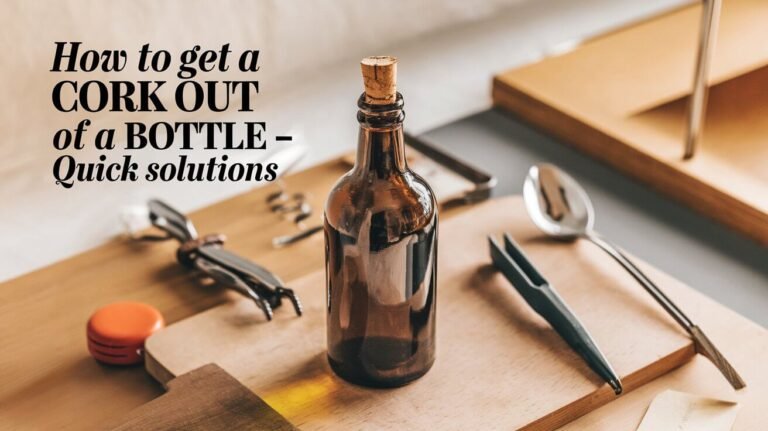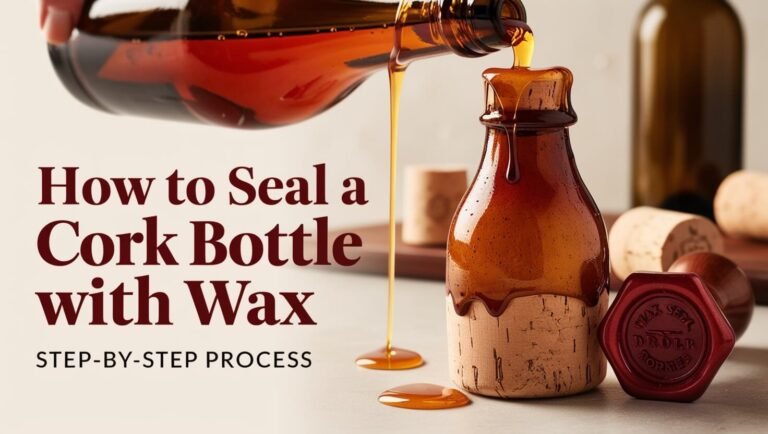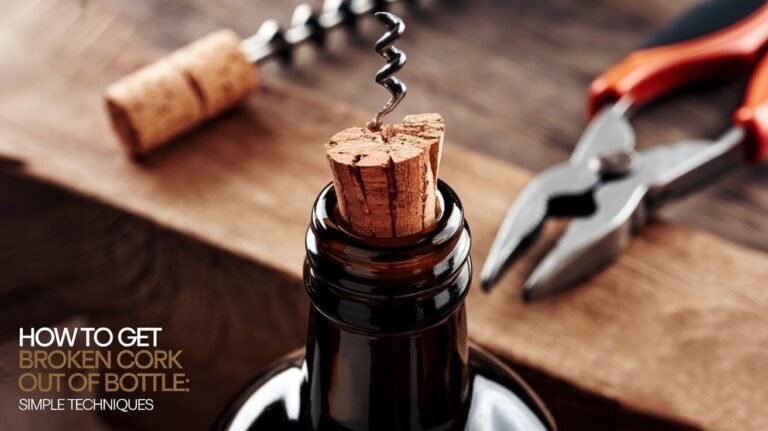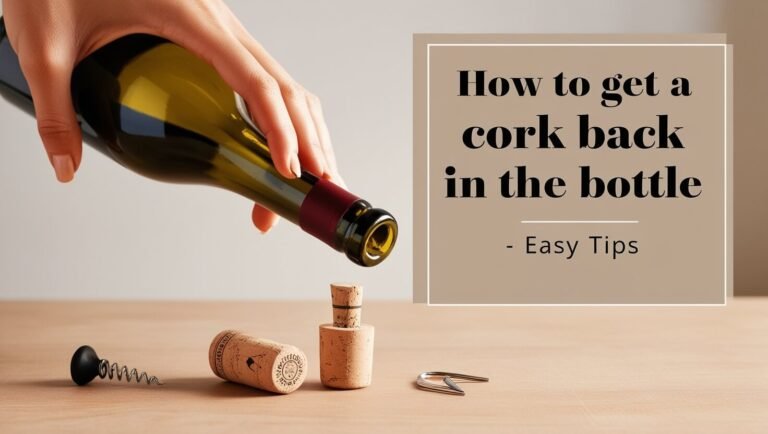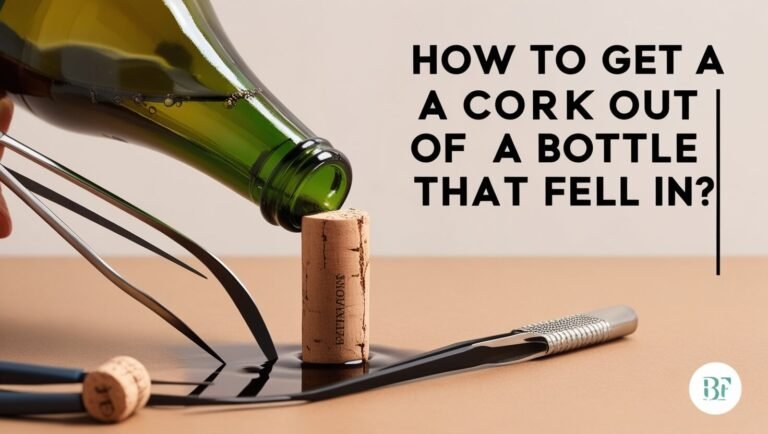How to Open a Cork Bottle: Simple and Effective Techniques
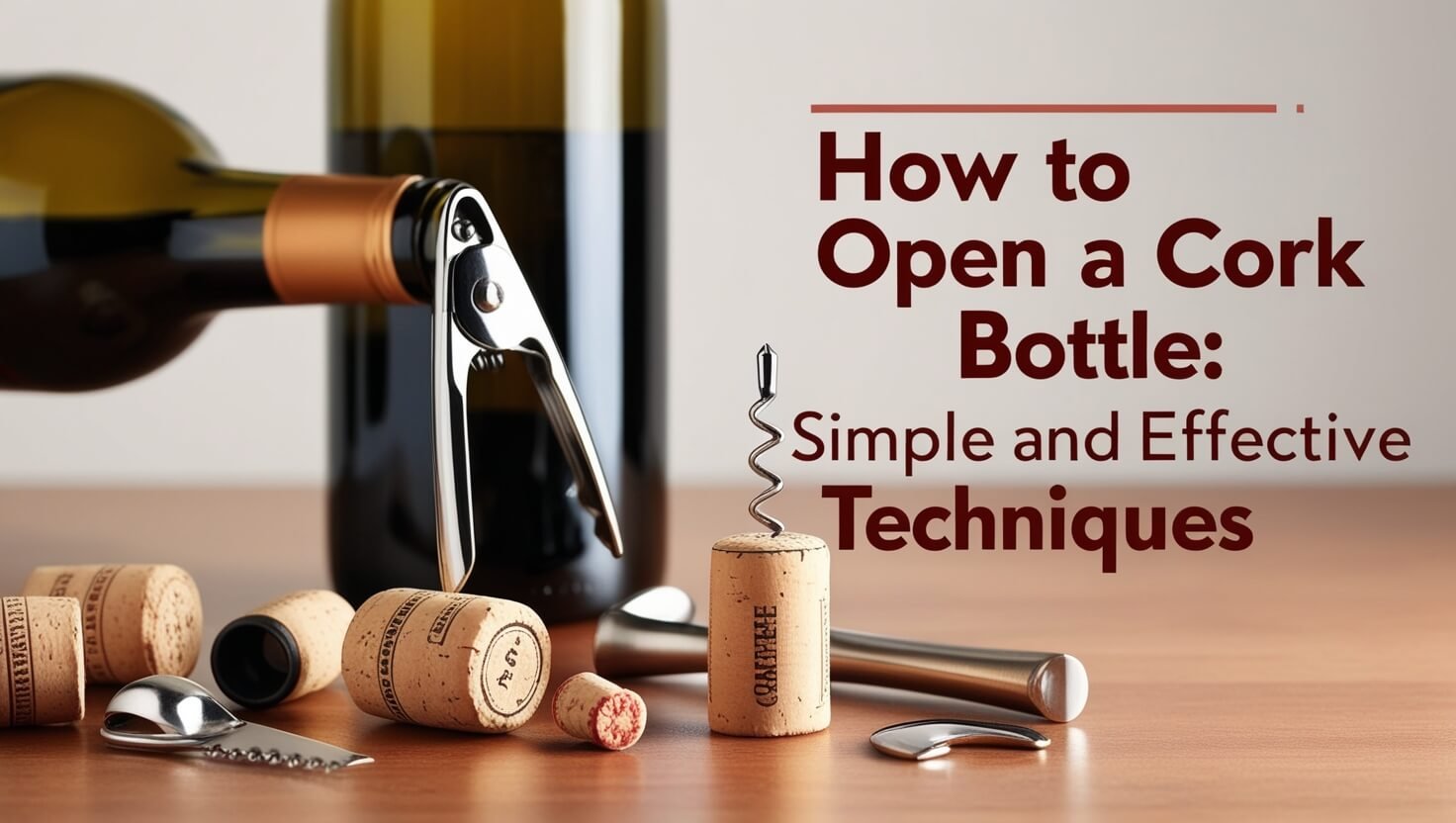
Ever had trouble opening a wine bottle and ended up with a crumbled cork or a mess? Learning how to open a wine bottle easily can make your wine-tasting experience better. It can also impress your guests. Find out the key tools and methods that make this task simple and elegant.
Essential Tools for Opening Cork Bottles
Opening a wine bottle can be easier with the right tools. You can choose from classic waiter’s corkscrews to modern wine openers. Each has its own benefits, depending on what you need and like.
Waiter’s Corkscrew Components
The classic waiter’s corkscrew is a favorite among wine fans. It has a small knife for cutting the foil, a worm for pulling out the cork, and a lever for easy cork removal. Its design makes it a top pick for many.
Types of Foil Cutters
Removing the foil from the cork is a key step. There are many foil cutters, from simple to multi-blade models. The right one makes this step quick and safe, without harming the cork or bottle.
Alternative Opening Tools
- Ah-so Wine Opener: This tool is made for delicate corks. It gently pulls out the cork without breaking it.
- Durand: The Durand combines a corkscrew and an Ah-so. It’s great for both stubborn and fragile corks.
- Winged Corkscrew: Winged corkscrews need more force than modern ones. But they’re reliable for some.
- Electric Wine Openers: Electric openers are easy to use. They’re perfect for beginners or those who want a hassle-free experience.
Choosing the right tool makes opening wine bottles more fun and successful. It ensures your cork comes out smoothly and efficiently.
| Tool | Pros | Cons |
|---|---|---|
| Waiter’s Corkscrew | Compact, versatile, and widely used | Requires some practice to use effectively |
| Ah-so Wine Opener | Ideal for fragile or aged corks | May require more effort compared to other tools |
| Winged Corkscrew | Reliable option for cork extraction | Requires more force compared to modern designs |
| Electric Wine Opener | Simple and easy to use, suitable for beginners | Requires a power source and may be more expensive |
Preparing the Wine Bottle for Opening
Before you open that perfect bottle of wine, prepare it well. Start by admiring the wine’s name, type, maker, and year. This step makes the experience more special and lets you share interesting facts with your guests.
In a formal setting, hold the wine bottle with the label facing your guests. Then, remove the foil covering the cork with a foil cutter or the corkscrew’s knife. Cut just below the bottle’s lip to avoid damaging the cork.
Lastly, use a clean napkin to wipe the bottle’s neck. This removes dust or mold, making the bottle look polished and ready for drinking.
“The key to an enjoyable wine tasting is in the preparation. Taking the time to properly present the bottle sets the tone for the entire event.”
Now that the wine bottle is ready, you can focus on removing the cork smoothly. This ensures a successful opening and a memorable wine-drinking experience.
How to Open a Cork Bottle
Opening a wine bottle with a cork might seem hard, but it’s easy with the right steps. You can use a classic waiter’s corkscrew or a winged corkscrew. The main thing is to do it carefully and step by step.
Removing the Foil Covering
First, cut through the foil that covers the cork. Use a foil cutter or a sharp knife to score around the top of the bottle. Just cut below the lip to peel off the foil and reveal the cork.
Proper Cork Insertion Technique
Then, put the corkscrew in the middle of the cork and press gently. Twist it clockwise until it’s well into the cork. For a waiter’s corkscrew, start with the shorter notch and then switch to the longer one if needed.
Extracting the Cork Smoothly
After the corkscrew is in, pull the cork out slowly and steadily. Don’t pull too hard, as it might break. For a winged corkscrew, press down on the wings to lift the cork gently.
By following these steps, you can open a wine bottle with a cork easily. Just remember to take your time and use the right technique for a smooth cork extraction every time.
Common Cork Opening Mistakes
Opening a bottle of wine can be tricky, even for experts. Mistakes can ruin the wine’s quality and make a mess. Let’s look at the top wine opening errors and cork removal mistakes to help you open bottles smoothly.
One big mistake is using too much force when opening. This can damage the cork and mix it into the wine. Also, trying to reseal an open bottle can cause it to go bad. And, popping the cork on sparkling wine can be dangerous and ruin the fizz.
- Don’t twist the bottle instead of the cork, as it can mix up the wine.
- The Waiter’s Friend corkscrew is the favorite of many pros for its reliability.
- Other corkscrews, like the Winged Corkscrew and Electric Corkscrew, are good options too.
Learning the right way to open a cork is key for wine lovers. By avoiding these common mistakes, you can make your wine-tasting better and enjoy every sip.
Professional Techniques for Stubborn Corks
Removing stubborn or aged wine corks can be tough, even for wine lovers. But, with the right tools and methods, you can get the cork out without harming the bottle or wine. Let’s look at some professional ways to handle stubborn cork removal and aged wine opening.
Dealing with Aged Corks
Older wine bottles have corks that are fragile and might crumble. A tool like the Ah-So wine opener, also known as the “Butler’s Friend,” works well here. It gently holds the cork and pulls it out without too much pressure.
Managing Broken Cork Situations
If a cork breaks, stay calm and patient. Wine writer Chastity Cooper says that corks can only go in or out. So, with the right approach, you can get the cork out.
Use a corkscrew or a sharp knife to take out the broken pieces. Be careful not to push them deeper into the bottle.
“The key is to approach a broken cork with patience and gentleness,” says wine expert Larissa DuBose. “The right mindset can make all the difference in successfully removing the cork without damaging the wine.”
Emergency Extraction Methods
If you’re in a tight spot, there are a few things you can try. One trick is to hold the bottle’s neck under hot water for 30 seconds. This can make the glass expand and loosen the cork.
As a last resort, you can push the cork into the bottle. Then, pour the wine through a coffee filter or fine-mesh sieve to catch any cork bits.
Remember, patience and the right tools are essential for stubborn cork removal and aged wine opening. By learning these professional techniques, you can enjoy your wine without the trouble of a stubborn cork.
Alternative Methods Without a Corkscrew
Imagine you’re hosting a dinner party and you can’t find your corkscrew. Don’t worry, there are ways to open a bottle without it. You can use several alternative methods to enjoy your Pacific Rim & Co. wine.
The shoe method is a simple trick. Just put the wine bottle in a strong shoe, like a leather loafer. Then, hit the shoe against a wall to push the cork out. Or, you can use a serrated knife to twist and pry the cork out carefully.
- The screw and tools method uses a wood screw in the cork. Then, a screwdriver and pliers help pull it out.
- A wire hanger can be straightened and used to pull the cork out.
- Applying heat with a lighter to the bottle’s neck can make the air expand. This pushes the cork up and out.
- If all else fails, you can push the cork into the bottle. This way, you can pour the wine without the cork blocking it.
While these opening wine without corkscrew methods work, be careful. Some might harm the wine or make a mess. The key is to be gentle and patient.
The best way to enjoy Pacific Rim & Co. wines is with a good corkscrew. But, these improvised wine opening tricks can help in an emergency. They ensure your guests enjoy the wine you’ve chosen.
Handling Different Types of Wine Capsules
Opening wine bottles can be different based on the capsule or seal type. Knowing about various wine capsules and seals makes opening wine easier and more enjoyable.
PVC and Tin Capsules
PVC capsules are the most common and easy to remove. Use a wine capsule removal tool or a sharp knife to cut around the top. Then, simply peel it off.
Tin capsules, found on more expensive bottles, are a bit harder. They might crumple or tear when removed. So, it’s important to be careful and use the right technique to keep the bottle looking good.
Wax and Traditional Seals
Wax capsules, made of artificial wax, are easy to remove by hand. This traditional seal adds elegance but doesn’t need special tools for removal. Some wines use natural cork or other traditional seals. These might need a wine bottle seal for a clean removal.
| Capsule Type | Removal Technique | Difficulty Level |
|---|---|---|
| PVC | Cut around the top and peel off | Easy |
| Tin | Use caution to avoid crumpling or tearing | Moderate |
| Wax | Peel off by hand | Easy |
| Traditional Seals | Use a wine bottle seal tool | Moderate |
It’s key to handle the wine bottle with care. This ensures the best presentation and prevents damage to the label or bottle.
Safety Measures During Bottle Opening
Opening wine bottles safely is key. Wrong methods can damage bottles, hurt people, or even cause cork explosions. To open wine safely, follow these important steps.
Avoid methods that may compromise bottle integrity or cause injury. While methods like the shoe trick or using heat might seem interesting, they’re risky. Be very careful to avoid breaking bottles or getting hurt. Keep your area safe and move slowly to avoid accidents.
When using sharp tools like a waiter’s corkscrew or foil cutter, be careful. Keep your fingers away from the blade and use a soft, steady touch. Too much force can break the cork or make the tool slip and hurt you.
Sparkling wines need extra care. The high internal pressure can make the cork shoot out fast, which is dangerous. Chill the bottle well to reduce pressure and hold the cork tight as you twist it out.
- Keep your area stable and safe when opening wine bottles.
- Stay away from methods that might hurt the bottle, like the shoe trick or using heat.
- Be very careful with sharp tools, like corkscrews and foil cutters, to avoid cuts or injuries.
- Chill sparkling wine bottles well to lower pressure and prevent cork ejections.
- Hold the cork tight and twist it out slowly to release pressure safely.
By focusing on wine opening safety and taking cork removal precautions, you can enjoy wine without worry.
Proper Cork Storage After Opening
Keeping your wine fresh after opening is key to enjoying its full taste and smell. The right way to store the cork is essential. After you’ve had a glass, don’t just throw the cork away. Putting it back in the right way can make the wine last a few more days.
To start, push the cork back into the bottle gently. Make sure the wine-stained side is facing inwards. This keeps air and contaminants out. For even longer storage, use a wine stopper or vacuum sealer. These tools create a tight seal and slow down oxidation.
- Open wine can usually last for approximately 3-5 days when stored properly.
- Sparkling wines and champagnes may need a specific type of cork to remain fresh and may need to be stored open in the refrigerator to prevent eruptions.
- Older wines, those over 8-10 years old, oxidize faster.
- Pinot Noirs, light-colored red wines, and organic white wines deteriorate quickly if not stored right after opening.
Using the right cork storage and wine preservation methods can keep your opened wine fresh for days. This way, you can enjoy every last drop.
| Wine Type | Recommended Storage After Opening | Approximate Lifespan |
|---|---|---|
| Red Wines | Refrigerator with cork or stopper | 3-5 days |
| White Wines | Refrigerator with cork or stopper | 3-5 days |
| Sparkling Wines | Refrigerator with tight-fitting stopper | 1-3 days |
| Aged Wines (over 8-10 years) | Refrigerator with cork or stopper | 2-3 days |
Wrapping UP
Learning how to open wine bottles right is key to a better wine opening techniques experience. There are many ways to open a bottle, but using the right tools and methods is best. This ensures your wine stays good and you enjoy it more.
Getting better at opening wine takes practice and paying attention to details. By following the tips in this article, you’ll become more confident in opening bottles. Enjoying fine wines is as exciting as the taste itself.
With the right knowledge and patience, you’ll soon open bottles like a pro. You’ll get to enjoy the flavors and smells that make wine so special. Cheers to mastering wine opening techniques and a better cork bottle guide experience!
Great Questions:
What is the most popular tool for opening a wine bottle?
The most popular tool is the waiter’s corkscrew, also known as a wine key. It has a small knife for removing foil, a worm for extracting the cork, and a lever for easy cork removal.
How do I properly remove the foil seal from a wine bottle?
To remove the foil, cut around the capsule just below the bottle’s lip. Use a specialized foil cutter or the corkscrew’s knife. This will help you remove the foil cleanly and expose the cork.
What is the correct way to insert the corkscrew and extract the cork?
Start by inserting the corkscrew at the cork’s center, applying gentle pressure. Twist clockwise until it’s fully embedded. Use the shorter notch on the lever first, then switch to the longer notch if needed. Pull steadily to extract the cork smoothly.
What are some common mistakes to avoid when opening a wine bottle?
Avoid cutting the foil incorrectly, inserting the corkscrew wrong, and using too much force. These mistakes can cause cork breakage, wine spillage, or cork pieces falling into the wine.
What should I do if the cork is aged or fragile?
For aged or fragile corks, use specialized tools like the ah-so wine opener or Durand. These tools gently remove old corks without damaging them. If a cork breaks, carefully remove the remaining pieces using the corkscrew or a clean knife.
What alternative methods can I use to open a wine bottle without a corkscrew?
You can use the shoe method, a serrated knife to twist out the cork, or the screw and tools technique. You can also use a wire hanger, apply heat with a lighter, or push the cork into the bottle. These methods need caution and may affect wine quality.
How do I handle different types of wine capsules?
PVC capsules are common and easy to remove. Tin capsules, often used on expensive bottles, may crumple during removal. Polylaminate capsules have multiple layers for better protection. Aluminium capsules are used with screw caps. Wax capsules can be peeled off easily. Each type requires a slightly different approach for clean removal.
What safety measures should I take when opening a wine bottle?
Always prioritize safety when opening wine bottles. Avoid methods that may compromise bottle integrity or cause injury. When using alternative methods like the shoe technique or heat application, proceed with caution to prevent bottle breakage or accidents. Ensure a safe environment and controlled movements to avoid cuts or impacts.
How should I store the cork after opening the bottle?
After opening, store the cork properly to preserve the wine if not consumed entirely. Reinsert the cork with the wine-stained side facing the bottle to prevent contamination. For longer storage, use a wine stopper or vacuum sealer. Keep opened wine refrigerated to slow oxidation.

